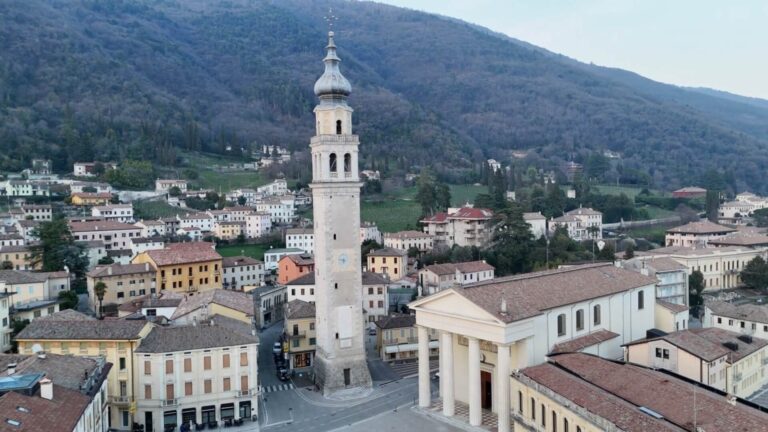ARTISTS’ ROADS
LE VIE DEGLI ARTISTI
watch the videos at the bottom of the page!
VALDOBBIADENE
The Sun and a Gnomon to Capture Time
Sundials are captivating instruments.
They represent one of the most practical and ingenious ways humankind has devised to capture time, to give it a visual form and to better understand its natural flow. The invention of mechanical clocks has not diminished their value. Mechanical clocks rely on a conventional time. Sundials, on the other hand, are more “precise”, because they are made to measure, based on the latitude and longitude of the place where they stand.
The principle is simple, yet brilliant: a small arm called a “gnomon”, from the Greek for “the one who indicates”. When struck by sunlight, it casts a shadow, ever-changing and untiring, that moves across a surface in step with the sun’s motion.
Its movement is confined to a defined space, known as the “solar quadrant”. They are graphically arranged in a radiating pattern, with each mark corresponding to an hour. Sometimes, you’ll spot a sort of elongated figure eight: the “lemniscate”. This traces the midday point, according to how the sun’s height shifts throughout the year in relation to the horizon. Naturally, sundials can be “out of service” in poor weather, but this, too, is part of their charm, their genuineness.
A working sundial depends on the skill of a specialist, a “gnomonist,” who calculates and designs each one individually.
Sundials are useful, but they are also beautiful. They are a match of science and art. They are often colourful, richly decorated. And they speak. Vivere memento: Remember to live. Omnes vulnerant. Ultima necat: Each one wounds. The last one kills. The sun often takes centre stage in these mottos: Sine sole sileo: Without the sun, I am silent. Nihil sine me: Nothing without me. They bear brief yet incisive mottos, in Italian, Latin, and at times in dialect, that question us, challenge us, and call us to account in our relationship with time.
It is no coincidence that many sundials appear on sacred buildings, or in religious contexts.
The poet Andrea Zanzotto, from Pieve di Soligo, had a passion for sundials. He once wrote, “They offer a lesson in reality, the clear and precise sense of the earth’s smallness and insignificance, like a speck of straw lost in the vastness of the universe.”
The province of Treviso has the third-highest number of sundials in Italy.
Their spiritual ancestor stands in Valdobbiadene, on the bell tower of the cathedral.
It was built in 1862 by a distinguished local figure: Abbot Giovanni Follador, mathematician, physicist, astronomer, and for thirty years a professor at the Episcopal College of Padua. Above all, he was an author of treatises on solar quadrants.
He could hardly have failed to build one, of the highest precision, in his own native town!
His great sundial appears in a photograph dated 1872.
It was destroyed in 1918 by Italian artillery and faithfully rebuilt only in 1998. From its place high above the town, it stands as a monument to its original creator. It marks five hours, from ten o’clock to two, indicates the months of the year, the signs of the zodiac, and reminds us that TIME AND LIFE NEVER STAND STILL.
Valdobbiadene thus reveals another of its many gifts: it is the guardian of a fascinating heritage of solar timekeeping. That’s why it was chosen in 2017 as the venue for the 21st National Gnomonics Seminar.
And in the light of this tradition, renewed in the present, a group of Venetian gnomonists launched a new initiative: the creation of a dedicated gnomonics room within the public library of Valdobbiadene.
Here, books, solar instruments, and a meticulously designed teaching display welcome visitors into the complex world of sundials, those extraordinary instruments that capture time and remind us, with artistry… That all things flow.
MORE EXPERIENCES!
Sine sole sileo. La magia degli orologi solari:
- Sarmede
- Nell’arcipretale di Mareno di Piave
- Nel duomo di Serravalle
- Nella cattedrale di Ceneda
MULTIMEDIAL MAP: “ARTISTS’ ROADS – LE VIE DEGLI ARTISTI- EN”!

